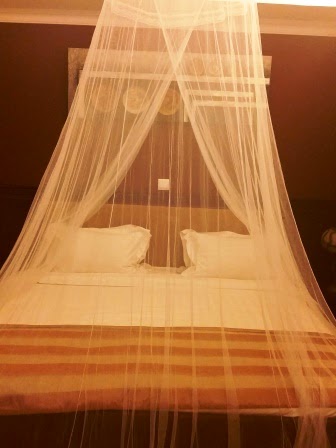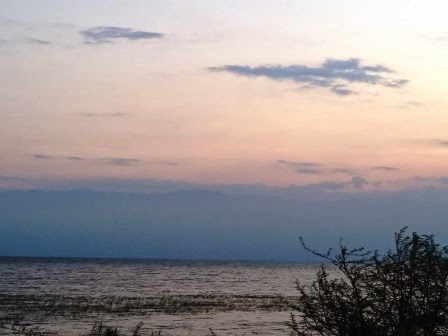 Bonjour from my 13th African country -- Democratic Republic of Congo (DRC)! I will admit my
Bonjour from my 13th African country -- Democratic Republic of Congo (DRC)! I will admit my American ignorance: when I was first confirmed for this trip and people inquired where I will be going I simply replied "Congo" as I thought "1) they will not know what I mean by DRC and 2) to state Democratic Republic of Congo is way too long ..." It was not until my arrival and in discussions with my colleagues that I realized Democratic Republic of Congo and Congo are two different countries! This is the blessing of travel - you are constantly being educated outside of what you know and learn in your home / comfort zone. Democratic Republic of Congo (DRC) and the Republic of Congo are neighbors, with the DRC being the larger of the two countries and Republic of Congo to its west. The flag of the Democratic Republic of the Congo is blue with a yellow star to the top left corner. The flag is split diagonally by a red stripe with a thin yellow frame. The color red represents the sacrifices of the national heroes, while the yellow represents the country's opulence and wealth; the star is a symbol of hope and ambition for the country and the blue field represents peace and harmony.
 When I first heard about this area of the world I was about 10 or 11 years old. The only girl in a neighborhood full of boys, I was excited when our new neighbors included another female - Sele. She was older than me, about 13 or 14, taller, thin, beautiful dark, smooth skin and she was always smiling. She was 1 of 3 siblings, from Zaire (now DRC), adopted by an interracial American couple. We were instant friends and would spend hours talking on our porch or at her dining room table trying new dishes she would cook for her family. She and her brothers would describe their country, the food, the dances and I would listen closely, imagining every detail as I never thought I would see that region of the world for myself. 23+ years later, here I am, in Kinshasa. Today I am learning even more about DRC from colleagues and people I meet in the hotel lobby, at the pizzeria or at the bar having a drink.
When I first heard about this area of the world I was about 10 or 11 years old. The only girl in a neighborhood full of boys, I was excited when our new neighbors included another female - Sele. She was older than me, about 13 or 14, taller, thin, beautiful dark, smooth skin and she was always smiling. She was 1 of 3 siblings, from Zaire (now DRC), adopted by an interracial American couple. We were instant friends and would spend hours talking on our porch or at her dining room table trying new dishes she would cook for her family. She and her brothers would describe their country, the food, the dances and I would listen closely, imagining every detail as I never thought I would see that region of the world for myself. 23+ years later, here I am, in Kinshasa. Today I am learning even more about DRC from colleagues and people I meet in the hotel lobby, at the pizzeria or at the bar having a drink.INTERESTING FACTS ABOUT DRC:
- DRC is the ancestral homeland for over 200 ethnic groups!
- DRC is quite large measuring almost 1/4 the size of the United States.
- There is only approximately 300 miles of paved road in DRC. Many goods, therefore, are transported via air.
- DRC's wealth can be attributed to its natural resources, which includes but is not limited to: oil, diamonds, gold, silver, coal and timber.
- Based on a recent study conducted by WHO, only 2% of the country's population is infected with / being treated for HIV/AIDS. This is lower than even the Washington DC area (at 3.2%, CDC) in the United States!
BONOBOS:
When you are in DRC you must visit Lola ya Bonobo. Founded by Claudine Andre in 1994, Lola ya Bonobo is the world's only sanctuary for orphaned bonobos. Lola ya Bonobo's mission is to rescue, rehabilitate and then release the bonobos back into the wild where they will hopefully replenish the population in the forest areas of DRC where they are becoming extinct. Interesting facts about bonobos:
- Bonobos are only found in one country - DRC.
- Bonobos are becoming extinct, rapidly. In 1980, 100,000 bonobos were reported living in DRC. Today only approximately 10,000 - 20,000 remaining. One of the reasons bonobos are becoming extinct is because of the bush meat trade. Their meat is considered a delicacy for which they are being slaughtered. Another reason is that female bonobos only give birth every 5 - 6 years. Deforestation is also a contributor to these animals becoming extinct.
- Humans share 98.7% of our DNA with bonobos! Their brains are highly developed, they also have five fingers on each hand and are able to walk long distances standing up right, walking on their two feet. Interestingly, during our visit the guide communicated in French with responses from the bonobos! In one example the guide threw sugar cane for their dessert. One of the closes bonobos caught the sugar cane and while he peeled the skin away the guide yelled "bon appetit!" to which the bonobo looked up, gave a toothy smile, nodded and then went back to the sugar cane!

Look at that expression!
 One may wonder what this male bonobo is pontificating :)
One may wonder what this male bonobo is pontificating :)
- Very unique in the animal kingdom and to bonobos is that the FEMALE bonobos are in charge! HBIC haha If a male bonobo becomes aggressive, the female bonobos surround him and block him from hurting the bonobo to which he is showing aggression. The males can even be punished for 'bad' behavior which is usually a hard bite administered by one of the females. If one female is having an issue with a male in the group, she will let out a loud cry and the other females will come running! During our visit one of the male bonobos had a plastic bottle which one of the females wanted. He ran up the hill to get away with the bottle, she let out the 'war cry' and before you knew it the male bonobo gave up the fight and gave the bottle to the female bonobo! Smart male! haha
- Bonobos are very peaceful and interestingly have never been seen to kill one of its own. How do they keep the peace? They "make love, not war" - literally. To diffuse tension, anxiety, stress or irritation bonobos engage in sexual contact, rubbing their genitals together. This as well as sex occurs indiscriminately, regardless of age or sex.
 |
| 4 year old bonobo quenching his thirst |
 |
| "Bonobo Beach" |
 |
| Mid-hiking photo op during visit to Bonobo ya Lola |
Part II of my adventure will be detailed in the next blog entry: Destination: Where to Eat, Dance and Play in Kinshasa.






























.jpg)




.jpg)
.jpg)
.jpg)

.jpg)



























